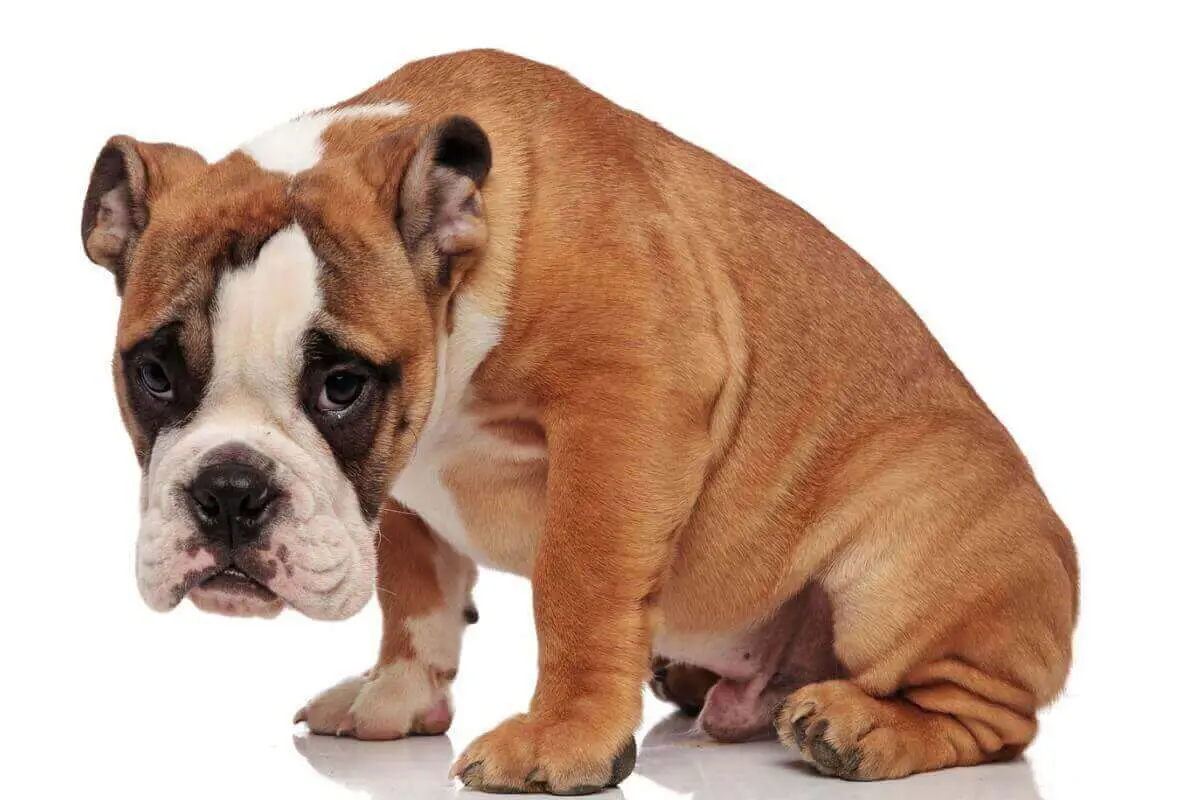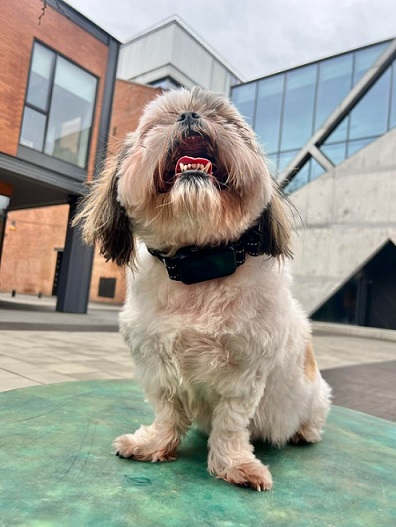Help! Why Does My Dog Hang His Head Low? Is He Okay?

We can all agree that our canine friend puts out some weird behaviors from time to time and there is a lot we can learn by observing their body language. While head tilting, raising, or lowering is quite common in dogs, you may not be surprised to find your dog hanging his head at a low position and there is no single reason why this happens.
Without further ado, let’s answer the question “why does dogs hang their heads low?
Often dogs hang their heads as a display of submission, anxiety, or guilt. It could also be a result of soft tissue injuries or various health problems such as degenerative disc diseases, atlantoaxial luxation, meningitis, stomach upset, osteoarthritis, cancer, or cognitive dysfunction.
Looking out for other symptoms will give you important clues about the potential causes. For example, a dog hanging his head low with a wobbly back leg or arched back will likely have a degenerative disease. In a case where this is behavior accompanied by yelping it may indicate that your dog is in pain.
If you suspect that your pooch has any health problems or are not sure of the reason for this behavior, simply consult your vet for medical advice, thorough examination, accurate diagnosis, and effective treatment.
Jump to Section
Why Does My Dog Hang His Head Low
There are a number of possible reasons why dogs suddenly start hanging their head down or low?
1. Submissive Behavior
When a submissive dog hangs his head low, he is trying to lower himself and look smaller in the face of a confrontation with other dogs. This behavior is used as a calming signal dogs to make themselves appear non-threatening and less aggressive. When dogs bow to initiate a playful interaction with another dog it is known as play bowing.
If your dog directs this behavior toward you, it indicates that he sees you as a leader who he respects, trusts, and loves.
2. Anxiety Or Fear
Anxiety can be a contributing factor to head-hanging behavior in dogs. Causes of anxiety range from separation, fear, and old age to a change of environment. It is important to plan ahead of time when dealing with anxiety in dogs.
While head hanging may be a mild symptom, at this stage, your dog should receive treatment because if this condition is allowed to advance, you can expect unfavorable behaviors like self-harm, damaging furniture, and excessive jumping.
Though it is not proven whether dogs can feel guilty or take cognizance of their wrongdoing, when scolded, in fear or stress, dogs may hunch their backs while hanging their head low.
3. Atlantoaxial Luxation
Genetically, small dog breeds like Yorkies, Chihuahuas, miniature Poodles, and Pomeranians are prone to a condition where there is an unstable and excessive movement of the first two bones of the vertebrae in the neck namely the atlas and axis. This is known as Atlantoaxial luxation. Large dog breeds can also develop this condition but it’s usually due to forceful movement that causes fractures or damaged ligaments.
Regardless of the cause, an instability between the atlas and axis during movement results in the compression of the spinal cord. Dogs with this condition are usually seen hanging their head at a low level. Other common symptoms associated with AA luxation in dogs include neck pain, uncoordinated movements, weakness, dyspnea, and paralysis of the neck and limbs.
4. Cervical Intervertebral Disc Disease
Dogs possess jelly-like discs between their vertebrae which act like shock absorbers providing cushion and support to the vertebrae and assisting mobility. When these discs become dry and hard, they lose their cushioning effects and if your dog continues moving, it ruptures and its contents press hard on the spinal cord.
This condition is termed IVDD. When this occurs in the neck region, it is known as Cervical IVDD. This condition is characterized by various symptoms such as back arching, head hanging, wobbly gait, and neck pain.
5. Lumbosacral Stenosis (Cauda Equina Syndrome)
This neurological condition is more common in older dogs and it occurs when there is a compression of the cauda equina, which is a collection of large nerves at the base of the spinal cord.
While this condition affects the lower back and hind limbs of dogs, at times, it can also cause your dog to assume a head-hanging posture. More commonly, cauda equina syndrome is characterized by hind limb paralysis, limping, difficulty in climbing stairs or running, abnormal tail movement, bowel and bladder incontinence, and lower back pain.
6. Osteoarthritis
Osteoarthritis is basically a form of arthritis caused by mechanical wear and tear of the joint cartilage responsible for providing cushioning effects. Older dogs, obese dogs, or large dog breeds are predisposed to osteoarthritis, but this condition can occur in all breeds and ages.
The inflammation of joints in these conditions causes pain, weakness, and mobility problems.
More commonly, osteoarthritis occurs in the joints of the forelimbs and hindlimbs but this condition is not limited to these regions as it can occur in the back and neck joints possibly leading to head hanging in dogs.
7. Spondylosis Deformans
Spondylosis deformans can cause neck stiffness and pain in dogs. In some cases, dogs with this condition can be seen hanging their head because there is a decreased range of movement.
In this condition, there is the formation of bony spur around the vertebrae which connects them and restricts motion. It is often associated with herniation of the intervertebral discs in dogs and it exists to restore the deficiency that causes instability in the joints.
Formation of bony spurs in the vertebrae can also result from other causes but it is usually non-inflammatory when caused by degenerative disc diseases.
8. Soft Tissue Injury
Trauma to soft tissue like muscles, tendons, ligaments, and nerves, especially in the neck region can cause head hanging in dogs. Injury to the trachea may also be the reason for this behavior
Traumatic experiences that may damage the soft tissues of your dog include falling from furniture, sliding on slippery floors, or getting hit by a vehicle and this condition can range from mildly concerning to life-threatening conditions.
Regular inspection not only helps discover soft tissue trauma but may also help in the early detection of diseases with superficial symptoms. It is imperative to take your dog to the vet for examination if you observe trauma or pain in any part of his body.
9. Meningitis
Meningitis describes a condition where the outer membrane of the brain and spinal cord is inflamed.
While this condition can be caused by bacterial, viral, fungal, and protozoal infections, it can also result from an immune-mediated response where the immune system launches a self-attack on its tissues.
Some tell-tale signs of meningitis include muscle spasms, lethargy, fever, neck pain, and rigidity. This explains why meningitis may lead to a head-hanging posture in dogs.
10. Neoplasia
In Neoplasia, there is a malfunction of the gene leading to uncontrolled and excessive growth of cells. This condition can be benign or malignant. When this happens, It can affect the functions of the vital organs in the surroundings and sometimes, metastasize to other parts of the body.
Neck or head tumors may develop from the lip, nasal cavity, oral cavity, paranasal sinuses, larynx, and pharynx. Though not common, it is possible that dogs with this condition will hang their head because of the resulting pain and discomfort.
11. Abdominal Pain
If your dog is recently hanging his head low, abdominal pain might be the culprit. It is important to also look out for other symptoms that may indicate that your dog is in pain.
There is no single cause of abdominal pain but it is commonly associated with gastrointestinal disturbances. If your dog is experiencing abdominal pain, you may notice signs like unusual vocalization of pain, bloat, diarrhea, fever, loss of appetite, or stepping away when you try to touch his belly.
12. Decreased Cognitive Functions
As dogs get older, they experience a gradual decrease in cognitive functions such as perception, awareness, learning, and memory, consequently affecting how dogs act. This is akin to dementia or Alzheimer’s disease in humans.
Behavioral changes often arise with cognitive dysfunction like disorientation, anxiety, alterations in sleep wake-cycle, low activity levels, decreased social interaction, and pacing in circles. When your dog forgets how to act, it’s he might hang his head low because he has become anxious and fearful.
A
What To Do If Your Dog Hangs His Head Low?
Here are various tips that may be helpful if you find your dog hanging his head down:
1. Talk To Your Vet
A dog with a stiff hanging head may not be able to carry out his normal daily activities and in the case where there is a joint problem, the condition may worsen if he continues moving without treatment.
The general rule of thumb is to talk to your vet about the situation to know whether your dog needs to be checked. However, if this condition is affecting your dog’s daily life, quickly visit the vet for diagnosis and treatment. The vet will also advise you on how to manage the condition if it is chronic.
2. Physical Therapy
It is important to consult your vet for advice before taking your dog to a chiropractor. However, dogs with joint problems are often advised to have a regular physical therapy sessions to re-establish the normal functionality and mobility of the joints. Dogs with mild conditions may need one therapy session monthly as opposed to twice a week for dogs with more serious conditions.
There are various types of canine physical rehabilitation therapy
- Passive Range of Motion (PROM): This involves the assisted movement of your dog’s joints in a way that it imitates the normal motion in turn improving the stretchability and helping recovery.
- Warm and Cold Therapy: The former is used before exercises to increase dogs’ blood circulation and metabolism. The latter produces the opposite effect by reducing blood circulation and preventing inflammation.
- Underwater Treadmill: Dogs with joint problems often have mobility problems. So, this unique type of treadmill may be less stressful for your dog’s joints due to the buoyant property of water.
- Acupuncture: This procedure involves the insertion of needles on different points where nerves meet blood vessels to balance energy flow and promote blood circulation. hormones with pain-relieving and anti-inflammatory effects are also stimulated in the process.
- Neuromuscular Stimulation: By firing muscles with low-level electric current, muscle spasms can be corrected and blood flow is improved to enhance healing. NMES also helps to relieve pain and prevent muscle atrophy.
- Laser Therapy: This uses a device that generates an intense beam of light that can alter tissue functions and physiology. It helps to stimulate the healing of inflamed cells and the destruction of scar tissues.
3. Consider Special Joint Supplements
Osteoarthritis is one of the possible reasons why your dog might be hanging his head down. Special joint supplements can be given to dogs to prevent osteoarthritis as well as to manage existing conditions.
Your dog does not necessarily need to have symptoms of joint problems before you opt for these nutritional supplements. Dog breeds that are prone to arthritis are always advised to include joint supplements in their diet regardless of whether they are showing any symptoms. It is important to have a discussion with your vet beforehand if you think your dog is predisposed to these conditions.
For dogs with an existing condition of osteoarthritis, joint supplements will help to reduce joint inflammation, relieve pain, restore the normal range of motion, and prevent unfavorable advancement of joint problems. Most of the commonly used joint supplements today contain major ingredients such as glucosamine, chondroitin, and omega-3 fatty acids.
4. Use Treat To Encourage Dog Neck Stretches
You can also lure your dog into stretching his neck by giving him treats with your hand at a high position. Make sure to first consult your vet to ensure that this exercise will not pose any harm to your pooch.
While stretching your dog’s neck may help promote mobility, be careful not to overstretch your dog as this can cause ligament injuries, muscle spasms, or strain.
Final Thoughts: My Dog Hangs His Head Low
Do you frequently observe your dog hanging his head? Kindly get in contact with your vet as this behavior can have various causes including conditions that are capable of advancing into a more severe state resulting in irreversible damage.
Furthermore, the importance of physical therapy cannot be overemphasized as this will help restore the normal joint function in your dog. A combination of physical rehabilitation and joint supplements is important in the management of osteoarthritis in dogs.
In essence, never ignore any abnormal behavior in your canine friend, instead, try to understand this behavior, find the cause, and help provide early treatment. Certainly, you will be rewarded with a heart-warming bundle of delight.
Read related posts about





